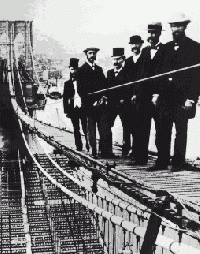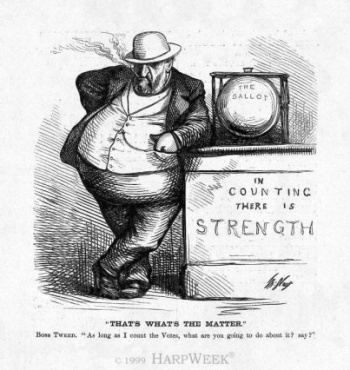From The Peopling of New York City
Where They Worked
Irish immigrants started off on the bottom of the occupational ladder. They took jobs that nobody else was willing to take, sometimes working as low as two cents a day. Immigrants took on hard manual labor in mills, railroad and canal construction, and sewers. Irish immigrant workers formed the base of the construction team to build the Brooklyn Bridge began in 1883. Many brave Irishmen died due to terrible working conditions. [1] It was hard, dangerous work, a common expression heard among the railroad workers was "an Irishman was buried under every tie." Irish women, young or old, worked as domestic servants in wealthy American families and textile factories. They became chamber maids, cooks, and the caretakers of children. Early Americans disdained this type of work, fit only for servants, the common sentiment being, "Let Negroes be servants, and if not Negroes, let Irishmen fill their place..." The Blacks hated the Irish and it appeared to be a mutual feeling. They were the first to call the Irish "white nigger." [2]
Because the competition for jobs was so fierce in the nineteenth century, Irish immigrants faced discrimination in the work force and saw signs like, “No Irish Need Apply.” Some businesses took advantage of Irish immigrants’ willingness to work at unskilled jobs for low pay. Employers were known to replace (or threaten to replace) uncooperative workers and those demanding higher wages with Irish laborers. [3] By the twentieth century, Irish Americans began climbing up the social leader because they were better educated and wealthier, and soon found a new niche in law enforcement, fire department, and politics. Tammany Hall appealed to the Irish immigrants by providing jobs and by 1900, Irish New Yorkers claimed more than one third fo the city's public jobs. [4] It is reported that as many as five out of six NYPD officers were of Irish descent by the turn of the century. Many also entered the political scene, such as the infamous Boss Tweed of Tammany Hall during the late 1800s and Al Smith, the four time governor of New York and Democratic Presidential Candidate for the election of 1928.
References
- ↑ Irish casualty on Brooklyn Bridge
- ↑ Irish women
- ↑ Irish workers
- ↑ Binder, Frederick, and David Reimers. All the Nations Under Heaven(99). New York: Columbia University Press, 1995
- Return to Occupational Patterns
- Return to Irish


